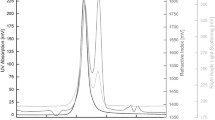Abstract
The quinol oxidase appears to be mainly responsible for the oxidation of bacterial MKH2 in Bacillus subtilis W23 growing with either glucose or succinate. The activity of the enzyme was maximum with dimethylnaphthoquinol, a water-soluble analogue of the bacterial menaquinol. Menadiol or duroquinol were less actively respired, and naphthoquinol was not oxidized at all. After fourtyfold purification the isolated enzyme contained 5.3 μmol cytochrome aa 3 per gram of protein and negligible amounts of cytochrome b and c. The turnover number based on cytochrome aa 3 was about 103 electrons · s-1 at pH 7 and 37°C. The preparation consisted mainly of a M r 57000 and a M r 36000 polypeptide. The N-terminal amino acid sequence of the latter polypeptide differed from that predicted by the qoxA gene of B. subtilis strain 168 (Santana et al. 1992), in that asp-14 predicted by qoxA was missing in the M r 36000 polypeptide.
Similar content being viewed by others
Abbreviations
- DMN:
-
2,3-dimethyl-1,4-naphthoquinone
- DMNH2 :
-
2,3-dimethyl-1,4-naphthoquinol
- Duroquinol:
-
2,3,5,6-tetramethyl-1,4-benzoquinol
- MK:
-
menaquinone
- MKH2 :
-
menaquinol
- NBH2 :
-
2,3-dimethoxy-5-methyl-6-(n-nonyl)-1,4-benzoquinol
- TMPD:
-
N,N,N′, N′,-tetramethyl-1,4-phenylenediamine
References
Bergsma J, Meihuizen KE, Oeveren W van, Konings WN (1982) Restoration of NADH oxidation with menaquinones and menaquinone analogues in membrane vesicles from the menaquinone-deficient Bacillus subtilis aroD. Eur J Biochem 125: 651–657
Bode CH, Goebell H, Stähler E (1968) Zur Eliminierung von Trübungsfehlern bei der Eiweißbestimmung mit der Biuretmethode. Z Klin Chem Klin Biochem 6: 418–422
Bradford MM (1976) A rapid and sensitive method for the quantitation of microgram quantities of protein utilizing the principle of protein-dye binding. Anal Biochem 72: 248–254
Brandt U, Schägger H, Jagow G von (1988) Characterisation of binding of the methoxyacrylate inhibitors to mitochondrial cytochrome c reductase. Eur J Biochem 173: 499–506
Carter K, Gennis RB (1985) Reconstitution of the ubiquinonedependent pyruvate oxidase system of Escherichia coli with the cytochrome o terminal oxidase complex. J Biol Chem 260: 10986–10990
Chepuri V, Lemieux L, Au DCT, Gennis RB (1990) The sequence of the cyo operon indicates substantial structural similarities between the cytochrome o ubiquinol oxidase of Escherichia coli and the aa 3-type family of cytochrome c oxidases. J Biol Chem 265: 11185–11192
Clark WM (1960) Oxidation reduction potentials of organic systems. Williams & Wilkins, Baltimore
Ernster L, Danielson L, Ljunggren M (1962) DT Diaphorase I, Purification from the soluble fraction of rat-liver cytoplasm, and properties. Biochim Biophys Acta 58: 171–187
Hägerhäll C, Aasa R, Wachenfeldt C von, Hederstedt L (1992) Two hemes in Bacillus subtilis succinate: menaquinone oxidreductase (complex II). Biochemistry 31: 7411–7421
James WS, Gibson F, Taroni P, Poole RK (1989) The cytochrome oxidase of Bacillus subtilis: mapping of a gene affecting cytochrome aa 3, and its replacement by cytochrome o in a mutant strain. FEMS Microbiol Lett 58: 277–282
Kadenbach B (1987) Evolution of a regulatory enzyme: cyrochrome c oxidase (complex IV). Curr Top Bioenerg 15: 113–160
Kita K, Konishi K, Anraki Y (1984) Terminal oxidases of Escherichia coli aerobic respiratory chain. II. Purification and properties of cytochrome b 585-d complex from cells grown with limited oxygen and evidence of branched electron-carrying systems. J Biol Chem 259: 3375–3381
Kröger A, Innerhofer A (1976) The function of the b cytochromes in the electron transport from formate to fumarate of Vibrio succinogenes. Eur J Biochem 69: 497–506
Kröger A, Unden G (1985) The function of menaquinone in bacterial electron transport. In: Lenaz G (ed) Coenzyme Q. Wiley, Chichester, pp 285–300
Lauraeus M, Haltia T, Saraste M, Wikström M (1991) Bacillus subtilis expresses two kinds of haem-A-containing terminal oxidases. Eur J Biochem 197: 699–705
Lemma E, Unden G, Kröger A (1990) Menaquinone is an obligatory component of the chain catalyzing succinate respiration in Bacillus subtilis. Arch Microbiol 155: 62–67
Lemma E, Hägerhäll C, Geisler V, Brandt U, Jagow G von, Kröger A (1991) Reactivity of the Bacillus subtilis succinate dehydrogenase complex with quinones. Biochim Biophys Acta 1059: 281–285
Magnusson K, Philips MK, Guest JR, Rutberg L (1986) Nucleotide sequence of the gene for cytochrome b 558 of Bacillus subtilis succinate dehydrogenase complex. J Bacteriol 166: 1067–1071
Meyer TE, Cusanovich MA (1989) Structure, function and distribution of soluble bacterial redox proteins. Biochim Biophys Acta 975: 1–28
Philips MK, Hederstedt L, Hasnain S, Rutberg L, Guest JR (1987) Nucleotide sequence encoding the flavoprotein and iron-sulfur protein subunits of the Bacillus subtilis PY79 succinate dehydrogenase complex. J Bacteriol 169: 864–873
Santana M, Kunst F, Hullo MF, Rapoport G, Danchin A, Glaser P (1992) Molecular cloning, sequencing, and physiological characterization of the qox operon from Bacillus subtilis encoding the aa 3-600 quinol oxidase. J Biol Chem 267: 10225–10231
Saraste M, Metso T, Nakari T, Jalli T, Lauraeus M, Oost J van der (1991) The Bacillus subtilis cytochrome-c oxidase. Eur J Biochem 195: 517–525
Schnorf U (1966) Der Einfluß von Substituenten auf Redoxpotential und Wuchseigenschaften von Chinonen. Doctoral thesis, no. 3871, ETH Zürich
Vrij W de, Azzi A, Konings WN (1983) Structural and functional properties of cytochrome c oxidase from Bacillus subtilis W23. Eur J Biochem 131: 97–103
Vrij W de, Burg B van den, Konings WN (1987) Spectral and potentiometric analysis of cytochromes from Bacillus subtilis. Eur J Biochem 166: 589–595
Wachenfeldt C von, Hederstedt L (1990) Bacillus subtilis 13-kilodalton cytochrome c-550 encoded by cccA consists of a membrane-anchor and a heme domain. J Biol Chem 265: 13939–13948
White PJ (1972) The nutrition of Bacillus megaterium and Bacillus subtilis. J Gen Microbiol 71: 505–514
Author information
Authors and Affiliations
Rights and permissions
About this article
Cite this article
Lemma, E., Schägger, H. & Kröger, A. The menaquinol oxidase of Bacillus subtilis W23. Arch. Microbiol. 159, 574–578 (1993). https://doi.org/10.1007/BF00249037
Received:
Accepted:
Published:
Issue Date:
DOI: https://doi.org/10.1007/BF00249037




